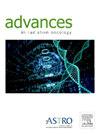Evaluating the Impact of Invasive Intubation on Treatment Accuracy in Head and Neck Cancer Patients Undergoing Image-Guided Radiation Therapy
IF 2.7
Q3 ONCOLOGY
引用次数: 0
Abstract
Purpose
To assess how nasogastric and tracheostomy tubes affect the precision of image-guided radiation therapy (IGRT) in head and neck cancer (HNC) patients.
Methods and Materials
A retrospective analysis was conducted on 79 patients treated with IGRT using the Varian EDGE linear accelerator at our institution from October 2021 to September 2023. Patients were divided into 3 groups based on the presence of invasive tubes: Group A with nasogastric tubes (n=29), Group B with tracheostomy tubes (n=20), and Group C without tubes (n=30). A total of 2580 displacement correction datasets were analyzed.
Results
Tracheostomy tubes significantly increased displacement errors in the X and Y-axes compared with patients without tubes (P =0.027 and P =0.028, respectively). Nasogastric tubes increased errors in the Yaw-axis compared with patients without tubes (P =0.034) and Pitch-axis errors compared with patients with tracheostomy tubes (P =0.008). The choice of immobilization mask also affected displacement accuracy; for instance, patients with tracheostomy tubes using the head and neck mask had lower X-axis displacement errors than those using the head-neck-shoulder mask (P <0.001).
Conclusions
Our findings indicate that Head and neck masks are preferable for patients with tracheostomy tubes, whereas head-neck-shoulder masks are better suited for those with nasogastric tubes. Customized asymmetric planning target volume margins for each tube–mask combination may further improve treatment accuracy and target coverage.
评估有创插管对影像引导放射治疗头颈癌患者治疗准确性的影响
目的探讨鼻胃管和气管造瘘管对头颈癌(HNC)患者影像引导放射治疗(IGRT)精度的影响。方法和材料回顾性分析了我院2021年10月至2023年9月使用瓦里安EDGE直线加速器接受IGRT治疗的79例患者。根据有无有创气管分为3组:A组有鼻胃管(n=29), B组有气管造口管(n=20), C组无气管造口管(n=30)。共分析了2580个位移校正数据集。结果与未使用气管插管的患者相比,气管插管显著增加了X轴和y轴位移误差(P =0.027和P =0.028)。鼻胃管与无鼻胃管患者相比,yw轴误差增加(P =0.034), pitch轴误差增加(P =0.008)。固定口罩的选择也会影响位移精度;例如,使用头颈面罩的气管造瘘管患者的x轴位移误差低于使用头颈肩面罩的患者(P <0.001)。结论气管造口管患者宜使用头颈面罩,鼻胃管患者宜使用头颈肩面罩。针对每种管面罩组合定制的非对称规划靶容积余量可进一步提高治疗精度和靶覆盖率。
本文章由计算机程序翻译,如有差异,请以英文原文为准。
求助全文
约1分钟内获得全文
求助全文
来源期刊

Advances in Radiation Oncology
Medicine-Radiology, Nuclear Medicine and Imaging
CiteScore
4.60
自引率
4.30%
发文量
208
审稿时长
98 days
期刊介绍:
The purpose of Advances is to provide information for clinicians who use radiation therapy by publishing: Clinical trial reports and reanalyses. Basic science original reports. Manuscripts examining health services research, comparative and cost effectiveness research, and systematic reviews. Case reports documenting unusual problems and solutions. High quality multi and single institutional series, as well as other novel retrospective hypothesis generating series. Timely critical reviews on important topics in radiation oncology, such as side effects. Articles reporting the natural history of disease and patterns of failure, particularly as they relate to treatment volume delineation. Articles on safety and quality in radiation therapy. Essays on clinical experience. Articles on practice transformation in radiation oncology, in particular: Aspects of health policy that may impact the future practice of radiation oncology. How information technology, such as data analytics and systems innovations, will change radiation oncology practice. Articles on imaging as they relate to radiation therapy treatment.
 求助内容:
求助内容: 应助结果提醒方式:
应助结果提醒方式:


